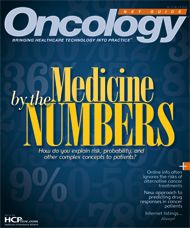Publication
Article
ONCNG Oncology
Cell Phone-based Telemonitoring Helps Cancer: Patients Adhere to Treatment Regimens
Author(s):
Wireless technologies like cell phones and radio frequency identification can help improve treatment compliance and quality of life for cancer patients.
Wireless technologies like cell phones and radio frequency identification can help improve treatment compliance and quality of life for cancer patients.
With oral cancer drugs being used more frequently, concern about medication compliance is an increasingly important issue in oncology. A review of compliance published in the Journal of the National Cancer Institute found that up to 80% of cancer patients failed to follow their prescriptions. Many cancer centers do not have a system that enables them to track patient compliance. Patients who receive too much chemotherapy risk a toxic reaction or long-term damage, whereas those who receive too little lose the therapeutic benefits of the drug.
Emerging cell phone-based telemonitoring technology has the potential to enhance medication compliance in oncology and clinical trials. Solutions have been recently introduced that integrate cell phones, radio frequency identification (RFID), and health and behavioral informatics to optimize medication compliance, track medication use, and extend patient care to the ambulatory setting.
Think of this technology as a “smart service” that leverages the inherent abilities of wireless technologies to allow clinicians to take action based upon hard data. In this case, medication data read from an RFID tag on the medication package is collected wirelessly in real time and helps verify that patients are taking the right drug at the right time, while tracking adverse events.
Patient acceptance of this technology has been high in pilot studies. Patients with prostate cancer enrolled in clinical trials who participated in usability testing at the National Cancer Institute User-Centered Informatics Research Lab reported that the technology made them feel more confident that they would be able to manage their medications. They said that such technology was reassuring, kept them aware and in touch, and prevented them from disregarding important symptoms. Clinicians participating in the testing also gave the technology high marks.
The best of these technologies are designed to facilitate compliance data collection and help manage adverse events. They go far beyond reminding patients to take their medications. These systems also help patients monitor their symptoms, side effects, and overall well-being, using commercially available smartphones that integrate seamlessly into their lifestyle. Alerts and notifications allow clinicians to intervene in the case of missed medications or adverse events before they become a significant health risk.
This technology was originally developed for cancer patients in clinical trials, and is now available to anyone who is looking for help in managing their medications, or who is a caregiver for someone who is. This type of telemonitoring service delivers the medication information patients need to know right to their cell phone, so they can monitor and manage treatment while they’re on the go. Some systems keep a log of each medicine, similar to a call log, making it easy for patients to give their doctor or pharmacist an accurate list. It also gives the scheduled medications for each day, making it easy to plan ahead. This approach represents the natural convergence of adherence, outcomes, and intervention in a breakthrough technology.
Barbara Rapchack is the CEO of Leap of Faith Technologies, maker of eMedonline.
